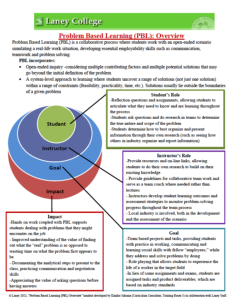ECT: PBL Scenarios

This collection is provided by Laney College and includes ten resources related to problem-based learning (PBL) that were used in the Commercial HVAC Systems certificate and associates degree program. This program prepares students to install and maintain commercial HVAC systems and controls. Safety, comfort, and energy efficiency through technical and computer-based skills are emphasized throughout the courses.
An overview diagram, a key points handout, four worksheets, and six sample scenarios are included.
The 2-page overview defines PBL and outlines the student's role, instructor's role, goal, and impact.
The 2-page Key Points handout includes sections on differentiating PBL/problem solving and troubleshooting, key components, criteria for developing PBL scenarios, and benefits of PBL.
The worksheets include a 10-step process student checklist, a "Need to Know" tool, a performance brainstorm sheet, and a performance indicator rubric.
The six PBL scenarios include:
- Fundamentals of Heating and Air Conditioning: Noisy Air Handling Unit #3 in Room B-150
- Residential and Light Commercial HVAC Installation: Installation of a furnace in a Residential House
- Heating, Ventilation, Air Conditioning System Design: Redesigning the Air Conditioning Layout for the 7th Floor Conference Room
- Commercial HVAC Systems: How to Keep the Chiller Running
- Advanced Direct Digital Controls: Why is the light on?
- Testing, Adjusting, and Balancing (TAB): Determine the Performance of the Air Conditioning System
The sample scenarios include key course concepts, learning objectives, the central problem, problematic situations, questions to consider, instructor and student roles and guidelines, and more.
Concepts covered in the scenarios include troubleshooting a noisy air conditioning unit, installing a furnace, designing a small HVAC system for a single commercial zone, demonstrating an understanding of building HVAC systems and the thermodynamics of heat transfer, troubleshooting a laser laboratory control system, and measuring system airflow while correctly completing testing, adjusting, and balancing (TAB) forms.
For orientation purposes, PBL_OverviewDiagram_Handout.pdf is included as a separate attachment and offers a sample of the type of material included.
Below is a list of the files included in the .zip attachment. The size of each file is included in parenthesis.
ECT: PBL Scenarios (13 files, 3.5 MB)
- ECT 16: Fundamentals of Heating and Air Conditioning (ECT16-HVAC Fundamentals_PBL_SampleScenario.pdf 262 KB)
- ECT 18: Residential and Light Commercial HVAC Installation (ECT18-HVAC Installation_PBL_SampleScenario.pdf 266 KB)
- ECT 23: Heating, Ventilation, Air Conditioning System Design (ECT23-HVAC Design_PBL_SampleScenario.pdf 266 KB)
- ECT 24: Commercial HVAC Systems (ECT24-HVAC Troubleshooting_PBL_SampleScenario.pdf 524 KB)
- ECT 27: Advanced Direct Digital Controls (ECT27-Adv DDC _PBL_SampleScenario.pdf 608 KB)
- ECT 212: Testing, Adjusting, and Balancing (TAB) (ECT212-TAB_PBL_SampleScenario.pdf 269 KB)
- Problem Based Learning (PBL) 10 Step Process Student Checklist (PBL_10StepProcess_StudentChecklist_Worksheet.pdf 201 KB)
- Problem Based Learning (PBL): Key Points (PBL_KeyPoints_Handout.pdf 206 KB)
- Problem Based Learning (PBL): Need to Know Worksheet (PBL_NeedToKnow_Worksheet.pdf 187 KB)
- Problem Based Learning (PBL): Overview (PBL_OverviewDiagram_Handout.pdf 238 KB)
- Problem Based Learning (PBL): Performance Indicator Brainstorm Sheet (PBL_PerformanceIndicatorBrainstorm_Worksheet.pdf 201 KB)
- Problem Based Learning (PBL): Performance Indicator Rubric (PBL_PerformanceIndicatorRubric_Worksheet.pdf 198 KB)
About this Resource


Comments